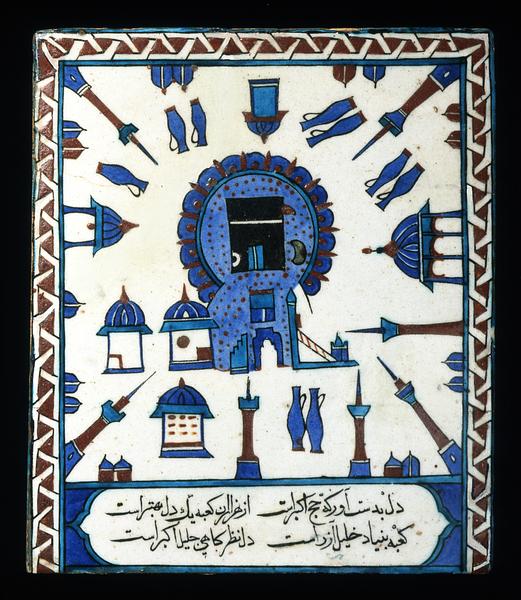“Pilgrim tile,” fritware
Turkey, Iznik; c. 1600
H: 34.5; W: 29.5 cm
Tiles like this one were presumably made as souvenirs for those who had completed the pilgrimage to Mecca, the hajj.
The painted decoration shows a stylized plan of the Holy Mosque in Mecca, with the Kaaba in the center of the courtyard. Paradoxically, the Persian poem at the bottom of the tile places greater emphasis on a pure heart than on the physical pilgrimage. “Bring your heart in your hand; it is more important than a pilgrimage / A single heart is better than a thousand Kaabas / The Kaaba was built by Khalil [Abraham] son of Azar / The heart, in contrast, is scrutinized by the Majestic, the Greatest [God].”
Inv. no. 51/1979
Published in:
Christie's, London, 20/4-1979, lot 34;
Annika Richert (red.): Islam: konst och kultur / art and culture, Statens historiska museum, Stockholm 1985, p. 105, cat.no. 3;
Art from the World of Islam. 8th-18th century, Louisiana, Humlebæk 1987, cat.no. 211;
Kjeld von Folsach: Islamic art. The David Collection, Copenhagen 1990, cat.no. 194;
Kjeld von Folsach, Torben Lundbæk and Peder Mortensen (eds.): Sultan, Shah and Great Mughal: the history and culture of the Islamic world, The National Museum, Copenhagen 1996, cat.no. 20;
Jessica Hallett, Conceicao Amaral (eds.): Cultures of the Indian Ocean, Museu Nacional de Arte Antiga, Lissabon 1998, cat.no. 49, pp. 196-197;
Kjeld von Folsach: Art from the World of Islam in The David Collection, Copenhagen 2001, cat.no. 269;
Ahmed Djebbar (ed.): L'age d'or des sciences arabes, Institut du monde arabe, Paris 2005, cat.no. 62, p. 128;
Hossam Elkhadem: À la découverte de l'age d'or des sciences arabes, catalogue de l'exposition itinérante, Université libre, Bruxelles, Bruxelles [2009], p. 9;
Charlotte Maury: “Depictions of the Haramayn on Ottoman tiles: content and context” in Venetia Porter and Liana Saif (eds.):The Hajj : collected essays, London 2013, p. 151, pl. 7;
Catharina Raudvere: Islam: an introduction, London 2015, p. 148, fig. 9;
Jan Loop: ”Lorcks Kaba-billede: Et samlingssted fro Abrahams børn” in Mikael Bøgh Rasmussen et al.: Melchior Lorck. Fakta, fiktion, fortolkning, Statens Museum for Kunst, 2023, p. 90 and 92, fig. 6;
